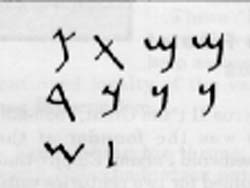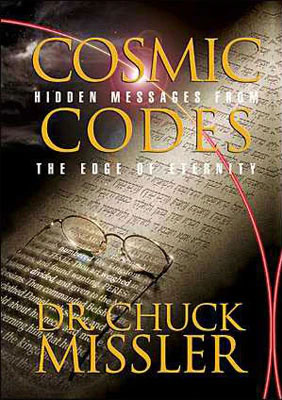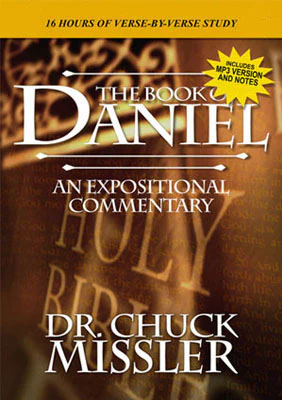It is the glory of God to conceal a thing: but the honour of kings is to search out a matter.
Proverbs 25:2
It may come as a surprise to many that there are ciphers encrypted in the Bible. Some are hidden; some, when revealed, are a key part of the narrative.
One of the first examples of deciphering a mysterious code-and certainly one of the most dramatic-occurred in Babylon during the fifth century B.C.
A Jewish prodigy by the name of Daniel was called into a royal celebration to decipher a baffling cryptogram which had interrupted the imperial festivities by mysteriously appearing on the wall of the banquet room.
His decipherment of this strange message declared the impending fall of the dominant world empire of the time.
This episode, recorded in the Bible in Daniel Chapter 5, has even resulted in several household idioms which still echo in our everyday language: "The handwriting on the wall," "your number is up," "you have been weighed and are found wanting," etc.
The Babylonian Empire
In 606 B.C. Nebuchadnezzar succeeded in his siege of Jerusalem and King Jehoiakim of Judah became his vassal. 1 The Prophet Jeremiah had predicted that the Babylonian Captivity of the Jews was to last 70 years, and it did; to the very day. 2
It was a result of this siege that Daniel and three of his friends were deported as teenagers to be educated and to serve at the Babylonian court.
These "hostages" would help assure the continued loyalty of the vassal king in Jerusalem.
Upon taking his throne, the young Nebuchadnezzar put his palace advisors to a test regarding an unusual dream which troubled him. 3
Daniel distinguished himself in describing and interpreting the dream, and this led to his ascendancy in the Babylonian court. This apparently also began an unusual relationship between Daniel and King Nebuchadnezzar. During a seven-year period of incapacity, Daniel was his personal attendant. 4
Nebuchadnezzar's Successors
Nebuchadnezzar's death was followed by a steady weakening of the regime. After one subsequent coup d'etat after another, ultimately Nabonidus came to the throne. However, Nabonidus indulged in foreign adventures in Palestine and Northern Arabia, leaving his son Belshazzar as co-regent in Babylon.
In the last year of Nabonidus the idols of the cities around Babylon, except Borsippa, Kutha, and Sippar, were brought in, which was an action taken only at the sign of impending war. Inscriptions also confirm Daniel as "the 3rd Ruler in the kingdom." 5
The Rise of Cyrus
Cyrus II ("the Great," 559-530 B.C.) was the founder of the Achaemenid Persian Empire that continued for two centuries until the time of Alexander the Great (331 B.C.). Young Cyrus succeeded in welding the Medes and Persians into a unified nation.
Babylon was in no position to resist a Medo-Persian invasion in the year 539 B.C. During the preceding fourteen years, Nabonidus the king had not so much as visited the capital city, leaving the administration of the metropolis to his profligate son Belshazzar, to whom he also "entrusted the kingship." 6
Toward the end of September, the armies of Cyrus, under the able command of Ugbaru, district governor of Gutium, attacked Opis on the Tigris River and defeated the Babylonians. This gave the Persians control of the vast canal system of Babylon. On October 10, Sippar was taken without a battle and Nabonidus fled. Two days later, on October 12, 539 B.C., Ugbaru's troops would be able to enter Babylon without a battle. The stage was now set for the strangest banquet in history.
The Banquet of Banquets
Instead of preparing to meet the Persian threat to his kingdom, Belshazzar decided to throw a royal party for a thousand of his lords. 7 To some extent, Bel-shazzar's overconfidence is understandable. Babylon was square, about 15 miles on each side. It boasted of an outside wall 87 feet wide-Herodotus records chariot races around the wall six abreast!
Inside this wall was a second wall, with a moat between them, and 250 watchtowers. The river Euphrates crossed the city, providing the water for both the protective moat and for survival purposes during a siege. Babylon was widely regarded as impregnable.
Belshazzar called for the vessels which had been taken from the Jewish Temple, captured by his grandfather Nebuchadnezzar 70 years earlier, to be exploited in the festivities. But just as the party seemed to really get rolling, giant fingers appeared, writing what was to become the most famous cryptogram of all time.
The Handwriting on the Wall
In the same hour came forth fingers of a man's hand, and wrote over against the lamp-stand upon the plaster of the wall of the king's palace: and the king saw the part of the hand that wrote.
Then the king's countenance was changed, and his thoughts troubled him, so that the joints of his loins were loosed, and his knees smote one against another.
Daniel 5:5-6
It is hard to improve on the quaint King James English! (Belshazzar's embarrassing lack of sphincter control also was a fulfillment of an ancient prophecy! We will review this shortly.)
In the ensuing panic, the king's advisors were at a loss to explain or interpret the strange writing. 8 But Nebuchadnezzar's widow reminded them of the previously demonstrated skills of Daniel-then possibly in retirement-and suggested that they call on him to address the enigma.
After an eloquent eulogy on his patron, Nebuchadnezzar-and a put-down of the young upstart-Daniel then deciphered the mysterious writing:
[24] Then was the part of the hand sent from him; and this writing was written.
[25] And this is the writing that was written, MENE, MENE, TEKEL, UPHARSIN.
 The Talmud suggests that the writing was vertical and backwards. Aramaic, like Hebrew, reads from right to left. (All languages seem to flow toward Jerusalem: those west of Jerusalem-the European languages-flow from left to right; those east of Jerusalem flow from right to left: Hebrew, Aramaic, Arabic, Chinese, etc.)
The Talmud suggests that the writing was vertical and backwards. Aramaic, like Hebrew, reads from right to left. (All languages seem to flow toward Jerusalem: those west of Jerusalem-the European languages-flow from left to right; those east of Jerusalem flow from right to left: Hebrew, Aramaic, Arabic, Chinese, etc.)
There is also a Hebrew tradition that this was an application of atbash, a form of encryption reviewed in last month's article. 9 (The deferral of any description of the text until its interpretation also implies something of that sort.)
MeNe, MeNe, TeKeL, PeReS. In Aramaic and Hebrew, vowels are absent and must be inferred. (This is also a common cryptographic practice used as a mechanism to reduce redundancy; the implications of this will be explored in future articles.)
[26] This is the interpretation of the thing: MENE; God hath numbered thy kingdom, and finished it. ("Your number is up.")
[27] TEKEL; Thou art weighed in the balances, and art found wanting.[28] PERES; Thy kingdom is divided, and given to the Medes and Persians.
Peres was previously rendered "upharsin": "u" is Aramaic for "and"; "pharsin" is the plural form of "peres." It means "broken" or "divided."
(By implying a different vowel, "paras" rather than "peres," this also becomes a play on words: paras was the word for Persia.) 10
[29] Then commanded Bel-shazzar, and they clothed Daniel with scarlet, and put a chain of gold about his neck, and made a proclamation concerning him, that he should be the third ruler in the kingdom.
However:
[30] In that night was Belshazzar the king of the Chaldeans slain.
The Fall of Babylon
Herodotus describes how the Persians had diverted the river Euphrates into a canal up-river so that the water level dropped "to the height of the middle of a man's thigh," which thus rendered the flood defenses useless and enabled the invaders to march through the river bed to enter by night. 11
Cyrus was able to boast that the conquest was virtually bloodless with no significant damage to the city. 12
God's Personal Letter to Cyrus
After Cyrus' triumphal entry into the city, Daniel then presented to him the writings of Isaiah13 that includes a letter addressed to Cyrus by name, written 150 years earlier: read it in Isaiah 44:24 - 45:6. Note particularly Isaiah 45:1,
Thus saith the LORD to his anointed, to Cyrus, whose right hand I have holden, to subdue nations before him; and I will loose the loins of kings, to open before him the two leaved gates; and the gates shall not be shut;
Notice the detail, "loose the loins of kings." Belshazzar's "brown britches" was also a fulfillment of prophecy! (This allusion to Cyrus also seems to confirm the public nature of Belshazzar's embarrassment.)
By calling him by name-written before he was born-Cyrus would realize that this was from God Himself. He was astonished. Wouldn't you be?
Cyrus was so stunned with the description of his entire career, including the circumstances regarding the fall of Babylon, that he arranged for the Hebrew captives to be released and permitted to return to Jerusalem. The Jews were actually encouraged by Cyrus to return and rebuild their temple. 14 He gave them back the vessels that Nebuchadnezzar had plundered from Solomon's Temple 70 years earlier and he contributed financially to the construction of their second temple. About 50,000 Jews responded to this royal proclamation and returned to Jerusalem under the leadership of Zerubbabel just seventy years after the captivity began, just as Jeremiah had predicted.
Babylon's Subsequent History
Serving as a secondary capital during the Persian and Greek Empires, Babylon ultimately atrophied to an insignificant byway. Another major Biblical enigma arises from the predictions by both Isaiah and Jeremiah 15 that call for Babylon's ultimate destruction in terms that have never occurred in history. Some regard the language as merely poetic or allegorical. Those that take the Bible more seriously look for Babylon to re-emerge in world history and ultimately receive the literal destruction described by the prophets. The recent rebuilding of Babylon begun by Saddam Hussein provides us an empirical test of this view. 16
This series of articles is being excepted from Chuck's forthcoming book, Cosmic Codes.
Notes:
- Jer 25:1. Nebuchadnezzar's first expedition was before he ascended to the throne; Nebuchadnezzar's first year was concurrent with Jehoia-kim's fourth year.
- Jer 25:11, 12. Failure to keep the Sabbath of the land for 490 years (70 times 7) was the cause for the particular period of 70 years of captivity. (2 Chr 36:21, cf. Mt 18:22.)
- The dramatic episode is detailed in Daniel Chapter 2.
- This is recorded in Daniel Ch. 4, written by Nebuchadnezzar himself. The Talmud indicates that Daniel provided his care during this period.
- The Babylon Chronicle, British Museum: this cylinder, one of 4 bearing the same text found at the four corners of the ziggurat at Ur, is inscribed in Babylonian cuneiform and mentions "Belshazzar, the son first (born) the offspring of my heart (body)."
- ;"Verse Account of Nabonidus," Pritchard, Ancient Near Eastern Texts, 313.
- This banquet hall (about 56 x 173 feet) has been reconstructed today and has been used by Saddam Hussein for affairs of state since 1987.
- Daniel 5:7-8.
- "The Bible Codes" Personal UPDATE, January 1998, p.7-10.
- Also, they may reflect a series of coins in use: a mina, a tekel (1/60th of a mina), and a peres, (a mina). Dr. Cyrus Gordon has suggested an American equivalent: "You will be quartered, halved, and cent to perdition." (David Kahn, The Code-breakers, Macmillan Company, NY, 1967, p.80.)
- Herodotus, 1.191.
- The famous Steele of Cyrus carries the inscription, "...without any battle, he entered the town, sparing any calamity...I returned to sacred cities on the other side of the Tigris, the sanctuaries of which have been ruins for a long time...and established for them permanent sanctuaries. I also gathered all their former inhabitants and returned to them their habitations." This cylinder, discovered by Hormuzd Rassam in the 19th century, can presently be examined in the British Museum in London.
- Josephus, Antiquities, XI, i.2.
- 2 Chr 36:22; Ezra 1:1-4.
- The great prophecies concerning the city of Babylon in Isaiah Ch. 13 and 14 and Jeremiah 50 and 51 have never been fulfilled. Yet.
- For a detailed exploration of these issues, see The Mystery of Babylon, or Chuck Missler's Expositional Commentary on Daniel, both available from Koinonia House.







